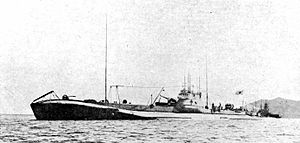| Japanese submarine I-54 (1926) | |
|---|---|
 Sister ship I-55 in harbor | |
| Career (Empire of Japan) | |
| Name: | I-54 |
| Builder: | Sasebo Naval Arsenal |
| Laid down: | 15 November 1924, as Submarine No. 77 |
| Launched: | 15 March 1926 |
| Completed: | 15 December 1927 |
| Renamed: | 20 May 1942, as I-154 |
| Struck: | 20 November 1945 |
| Fate: | Scuttled, 1946 |
| General characteristics | |
| Class & type: | Kaidai-class submarine (KD3A Type) |
| Displacement: |
|
| Length: | 100 m (328 ft 1 in) |
| Beam: | 8 m (26 ft 3 in) |
| Draft: | 4.82 m (15 ft 10 in) |
| Installed power: |
|
| Propulsion: |
|
| Speed: |
|
| Range: |
|
| Test depth: | 60 m (200 ft) |
| Complement: | 60 |
| Armament: |
|
The Japanese submarine I-54 was a Kaidai-class cruiser submarine of the KD3A sub-class built for the Imperial Japanese Navy (IJN) during the 1920s. She supported Japanese forces during the invasion of Malaya in December 1941 and the Dutch East Indies campaign in early 1942.
Design and description[]
The submarines of the KD3A sub-class were the first Japanese-designed cruiser submarines, based on experience with earlier designs based on British and German cruiser submarines.[1] They displaced 1,829 metric tons (1,800 long tons) surfaced and 2,337 metric tons (2,300 long tons) submerged. The submarines were 100 meters (328 ft 1 in) long, had a beam of 8 meters (26 ft 3 in) and a draft of 4.82 meters (15 ft 10 in). The boats had a diving depth of 60 m (200 ft) and a complement of 60 officers and crewmen.[2]
For surface running, the boats were powered by two 3,400-brake-horsepower (2,535 kW) diesel engines, each driving one propeller shaft. When submerged each propeller was driven by a 900-horsepower (671 kW) electric motor. They could reach 20 knots (37 km/h; 23 mph) on the surface and 8 knots (15 km/h; 9.2 mph) underwater. On the surface, the KD3As had a range of 10,000 nautical miles (19,000 km; 12,000 mi) at 10 knots (19 km/h; 12 mph); submerged, they had a range of 90 nmi (170 km; 100 mi) at 3 knots (5.6 km/h; 3.5 mph).[3]
The boats were armed with eight internal 53.3 cm (21.0 in) torpedo tubes, six in the bow and two in the stern. They carried one reload for each tube; a total of 16 torpedoes. They were also armed with one 120 mm (4.7 in) deck gun for combat on the surface.[4]
Construction and career[]
Built by the Sasebo Naval Arsenal, I-54 was laid down as Submarine No. 77 on 15 November 1924, but was redesignated as I-54 before the end of the year.[5] The boat was launched on 15 March 1926 and completed on 15 December 1927.[2] On 10 February 1932, she was slightly damaged when she accidentally rammed by her sister ship, I-55. The boat was often placed in reserve for several months at a time during the late 1930s.[5]
Notes[]
References[]
- Bagnasco, Erminio (1977). Submarines of World War Two. Annapolis, Maryland: Naval Institute Press. ISBN 0-87021-962-6.
- Carpenter, Dorr B. & Polmar, Norman (1986). Submarines of the Imperial Japanese Navy 1904–1945. London: Conway Maritime Press. ISBN 0-85177-396-6.
- Chesneau, Roger, ed (1980). Conway's All the World's Fighting Ships 1922–1946. Greenwich, UK: Conway Maritime Press. ISBN 0-85177-146-7.
- Hackett, Bob; Kingsepp, Sander (2013). "IJN Submarine I-154: Tabular Record of Movement". combinedfleet.com. http://www.combinedfleet.com/I-154.htm. Retrieved 6 November 2015.
- Jentschura, Hansgeorg; Jung, Dieter & Mickel, Peter (1977). Warships of the Imperial Japanese Navy, 1869–1945. Annapolis, Maryland: United States Naval Institute. ISBN 0-87021-893-X.
The original article can be found at Japanese submarine I-54 (1926) and the edit history here.